US Landings
Commercial landings (edible and industrial) by US fishermen at ports in the 50 states were 8.3 billion pounds or 3.8 million metric tons valued at $4.4 billion in 2008 – a decrease of 983.4. million pounds (down 11 per cent) and an increase of $191.6 million (up 5 per cent) compared with 2007. Finfish accounted for 87 per cent of the total landings, but only 51 per cent of the value. The 2008 average ex-vessel price paid to fishermen was 53 cents compared to 45 cents in 2007.
Catches of Alaska pollock, Pacific whiting and other Pacific groundfish that are processed at-sea aboard US vessels in the northeastern Pacific are credited as 'landings' to the state nearest to the area of capture. Information on landing port or percentage of catch transferred to transport ships for delivery to foreign ports is unavailable. These at-sea processed fishery products, on a round (live) weight basis, exceeded 1.1 million metric tons in 2008 and comprised less than 30 per cent of the total domestic landings in the 50 states.
Commercial landings by US fishermen at ports outside the 50 states along with Internal Water Processing (IWP) agreements (see glossary) provided an additional 250.9 million pounds (113,886 metric tons) valued at $89.9 million. This was an increase of 58 per cent, or 92.6 million pounds (42,048 metric tons) in quantity and $27.4 million (44 per cent) in value compared with 2007. Most of these landings consisted of tuna, and swordfish landed in American Samoa and other foreign ports.
Edible fish and shellfish landings in the 50 states were 6.6 billion pounds (3.0 million metric tons) in 2008 – a decrease of 856,700 thousand pounds (389 metric tons) compared with 2007.
Landings for reduction and other industrial purposes were 1.7 billion pounds (767,639 metric tons) in 2008 – a decrease of 7 per cent compared with 2007. The 2008 US marine recreational finfish catch (including fish kept and fish released (discarded)) on the Atlantic, Gulf, and Pacific coasts was an estimated 463.9 million fish taken on an estimated 84.8 million fishing trips. The harvest (fish kept or released dead) was estimated at 196.7 million fish weighing 247.6 million pounds.
World Landings
In 2007, the most recent year for which data are available, world commercial fishery landings and aquaculture production were 140.4 million metric tons – an increase of 3.2 million metric tons compared with 2006. China was the leading nation with 32.8 per cent of the total harvest followed by India and Peru with 5.2 per cent. Indonesia was the fourth leading producer with 4.5 per cent and the United States was fifth with 3.8 per cent.
Prices
The 2008 annual ex-vessel price index for edible fish increased by 57 per cent, shellfish increased 8 per cent and industrial decreased 12 per cent comparing with 2007. Ex-vessel price indices increased for 26 out of 32 species groups being tracked, decreased for 5 species groups, and unchanged for one species groups. The yellowfin tuna price index had the largest increase (158 per cent) while haddock price index showed the largest decrease (24 per cent).
Processed Products
The estimated value of the 2008 domestic production of edible and nonedible fishery products was $7.6 billion, $794.9 million less than in 2007. The value of edible products was $7.0 billion – a decrease of $748.7 million compared with 2007. The value of industrial products was $565.8 million in 2008 – a decrease of $46.2 million compared with 2007.
Foreign Trade
The total import value of edible and nonedible fishery products was $28.5 billion in 2008 – a decrease of $320.5 million compared with 2007. Imports of edible fishery products (product weight) were 5.2 billion pounds valued at $14.2 billion in 2008 – a decrease of 120.4 million pounds but an increase of $474.6 million compared with 2007. Imports of non-edible (i.e., industrial) products were $14.3 billion – a decrease of $795.1 million compared with 2007.
Total export value of edible and non-edible fishery products was $23.4 billion in 2008 – an increase of $3.3 billion compared with 2007. United States firms exported 2.7 billion pounds of edible products valued at $4.3 billion – a decrease of 219.3 million pounds and a decrease $11.8 million compared with 2007. Exports of nonedible products were valued at $19.1 billion, $3.3 billion more than 2007.
Supply
The US supply of edible fishery products (domestic landings plus imports, round weight equivalent, minus exports) was 11.8 billion pounds in 2008 – a decrease of 655.6 million pounds compared with 2007. The supply of industrial fishery products was 1.1 billion pounds in 2008 – an increase of 50.2 million pounds compared with 2007.
Per Capita Consumption
US consumption of fishery products was 16.0 pounds of edible meat per person in 2008, down 0.3 pound from the 2007 per capita consumption of 16.3 pounds.
Consumer Expenditure
US consumers spent an estimated $69.8 billion for fishery products in 2008. The 2008 total includes $46.8 billion in expenditures at food service establishments (restaurants, carry-outs, caterers, etc.); $22.7 billion in retail sales for home consumption; and $389.4 million for industrial fish products. By producing and marketing a variety of fishery products for domestic and foreign markets, the commercial marine fishing industry contributed $35.0 billion (in value added) to the US Gross National Product.
Major US Fishing States
Alaska led all states in volume with landings of 4.5 billion pounds, followed by Louisiana 916.0 million pounds; Washington 568.6 million pounds, Virginia 415.7 million pounds; and Massachusetts 326.1 million pounds.
Alaska led all states in value of landings with $1.7 billion, followed by Massachusetts, $399.6 million; Maine, $287.5 million; Louisiana, $272.9 million and Washington $250.8 million.
Dutch Harbor-Unalaska, Alaska, was the leading US port in quantity of commercial fishery landings, followed by: Reedville, Virginia; Empire-Venice, Louisiana; Intracoastal City, Louisiana, and Kodiak, Alaska New Bedford, Massachusetts was the leading US port in terms of value, followed by; Dutch Harbor-Unalaska, Alaska; Kodiak, Alaska; Cape May-Wildwood, New Jersey; and Honolulu, Hawaii.
Tuna landings by US-flag vessels at ports outside the continental United States amounted to 250.9 million pounds.
Main Species Landed
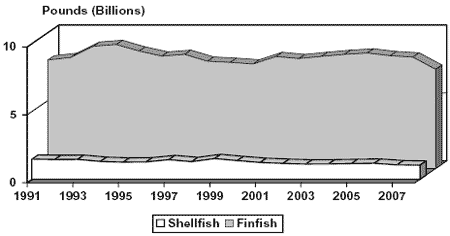
1991-2008
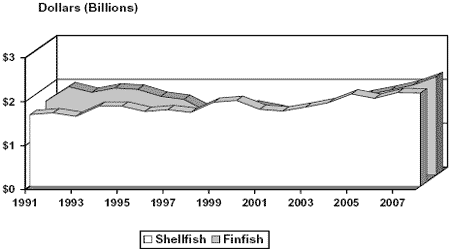
1991-2008
| Major US domestic species landed in 2008 ranked by quantity and value (numbers in thousands) |
|||||
|---|---|---|---|---|---|
| Quantity | Value | ||||
| Rank | Species | Pounds | Rank | Species | Value ($) |
| 1 | Pollock | 2,298,112 | 1 | Crabs | 562,267 |
| 2 | Menhaden | 1,341,413 | 2 | Shrimp | 441,818 |
| 3 | Flatfish | 663,116 | 3 | Salmon | 394,594 |
| 4 | Salmon | 658,342 | 4 | Scallops | 371,641 |
| 5 | Hakes | 549,572 | 5 | Lobster | 336,902 |
| 6 | Cod | 513,027 | 6 | Pollock | 334,477 |
| 7 | Crabs | 325,184 | 7 | Cod | 304,895 |
| 8 | Herring (sea) | 259,436 | 8 | Halibut | 217,735 |
| 9 | Shrimp | 256,597 | 9 | Clams | 186,718 |
| 10 | Sardines | 193,078 | 10 | Flatfish | 184,209 |
Alaska Pollock and Other Pacific Trawl Fish
US landings of Pacific trawl fish (Pacific cod, flounders, hake, Pacific ocean perch, Alaska pollock and rockfishes) were 4 billion pounds valued at $815.2 million – a decrease of 11 per cent in quantity and an increase of 20 per cent in value compared with 2007. Landings of Alaska pollock (2.3 billion) decreased from 2007 and were 1 billion pounds under their 2003 to 2007 five-year average. Landings of Pacific cod were 494 million pounds – an increase of over 1 per cent from almost 487.6 million in 2007. Pacific hake (whiting) landings were more than 531.4 million pounds (up 17 per cent) valued at $58.6 million (up 80 per cent) compared to 2007. Landings of rockfishes were 35 million pounds (up 10 per cent) and valued at $17 million (up 17 per cent) compared to 2007.
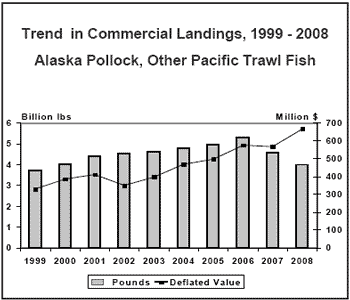
Anchovies
US landings of anchovies were 32.4 million pounds – an increase of 9.1 million pounds (39 per cent) compared with 2007. One per cent of all landings were used for animal food or reduction and 99 per cent were used for bait. The US imports all edible anchovies.
Halibut
US landings of Atlantic and Pacific halibut were 66.9 million pounds (round weight) valued at $217.7 million – a decrease of 3 million pounds (4 per cent) and $9.6 million (4 per cent) compared with 2007. The Pacific fishery accounted for all but 58,000 pounds of the 2008 total halibut catch. The average ex-vessel price per pound in 2008 was $3.25 unchanged from 2007.
Sea Herring
US commercial landings of sea herring were 259.4 million pounds valued at $45.1 million – an increase of 26.7 million pounds (11 per cent), and $10.2 million (29 per cent) compared with 2007. Landings of Atlantic sea herring were 173.2 million pounds valued at $21.3 million – an increase of 9.8 million pounds (6 per cent), and $1.7 million (9 per cent) compared with 2007. Landings of Pacific sea herring were over 86.2 million pounds valued at $23.8 million – an increase of 16.9 million pounds (24 per cent) and $8.5 million (55 per cent) compared with 2007. Alaska landings accounted for 97 per cent of the Pacific coast with 83.8 million pounds valued at $22.9 million – an increase of 16.6 million pounds (25 per cent), and $8.1 million (55 per cent) compared with 2007.
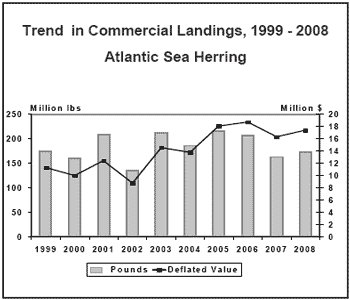
Jack Mackerel
California accounted for 97 per cent, Oregon for 1 per cent, and Washington 2 per cent of the US landings of jack mackerel in 2008. Total landings were 623,000 pounds valued at $58,000 – a decrease of 792,000 pounds (56 per cent), and $87,000 (60 per cent) compared with 2007. The 2008 average ex-vessel price per pound was 9 cents.
Mackerel, Atlantic
US landings of Atlantic mackerel were 48 million pounds valued at $6.9 million – a decrease of 8.4 million pounds (15 per cent), but an increase of $152,000 (2 per cent) compared with 2007. Massachusetts with 35.4 million pounds and New Jersey with 9.4 million pounds accounted for almost 94 per cent of the total landings. The average ex-vessel price per pound in 2008 was 14 cents compared with 12 cents in 2007.
Mackerel, Chub
Landings of chub mackerel were 7.9 million pounds valued at $710,000 – a decrease of 4.1 million pounds (34 per cent), and $130,000 (15 per cent) compared with 2007. California accounted for 99 per cent of the total landings. The average ex-vessel price in 2008 was 9 cents compared with 7 cents in 2007.
Menhaden
The US menhaden landings were 1.3 billion pounds valued at $90.7 million – a decrease of 142.3 million pounds (10 per cent), and $2 million (2 per cent) compared with 2007. Landings decreased by 64.5 million pounds (13 per cent) in the Atlantic states, while decreasing by 77.8 million pounds (8 per cent) in the Gulf states compared with 2007. Landings along the Atlantic coast were 413.9 million pounds valued $26.4 million. Gulf region landings were 927.5 million pounds valued at $64.4 million.
Menhaden are used primarily for the production of meal, oil, and solubles, while small quantities are used for bait.
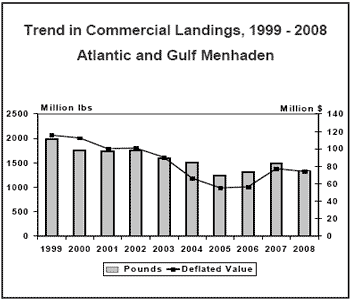
North Atlantic Trawl Fish
Landings of butterfish, Atlantic cod, cusk, flounders (winter/blackback, summer/fluke, yellowtail and other), haddock, red and white hake, ocean perch, pollock and whiting (silver hake) in the North Atlantic (combination of New England, Middle Atlantic, and Chesapeake Regions) were 97.6 million pounds valued at $113.9 million – an increase of 10.2 million pounds (12 per cent), and $5.1 million (5 per cent) compared with 2007. Of these species, flounders led in total value in the North Atlantic, accounting for 37 per cent of the total; followed by cod, 27 per cent; and haddock, 14 per cent.
The 2008 landings of Atlantic cod were 19.1 million pounds valued at $30.6 million – an increase of 2.1 million pounds (12 per cent), and $3.6 million (13 per cent) compared with 2007. The ex-vessel price per pound in 2008 was $1.61 compared with $1.60 in 2007. Landings of yellowtail flounder were 3.7 million – a decrease of 192 thousand pounds (5 per cent) from 2007 and were 60 per cent lower than the 5-year average. Haddock landings increased to 14 million pounds (75 per cent) and $16.4 million (33 per cent) compared to 2007.
North Atlantic pollock landings were 22 million pounds valued at $11.3 million – an increase of 3.5 million pounds (19 per cent), and $2.7 million (32 per cent) compared with 2007.
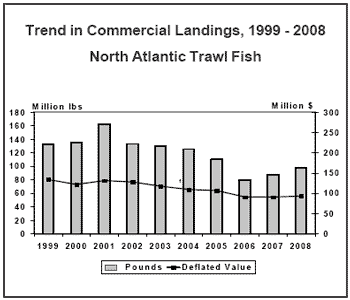
Pacific Salmon
US commercial landings of salmon were over 658.3 million pounds valued at almost $394.6 million – a decrease of 226.7 million pounds (26 per cent), but an increase of $13.3 million (3 per cent) compared with 2007. Alaska accounted for 97 per cent of total landings; Washington, 2 per cent; California, Oregon, and the Great Lakes accounted for less than 1 per cent of the catch. Sockeye salmon landings were 224.8 million pounds valued at $175.9 million – a decrease of 51.8 million pounds (19 per cent) and $29.4 million (14 per cent) compared with 2007. Chinook salmon landings decreased to 9.8 million pounds-down 4.8 million pounds (33 per cent) from 2007. Pink salmon landings were 260.5 million pounds-a decrease of 196.9 million (43 per cent); chum salmon landings were 125.8 million-an increase of 16.6 million (15 per cent); and coho salmon increased 37.4 million – an increase of 10.2 million (38 per cent) compared with 2007.
Alaska landings were 640.1 million pounds valued at $368.2 million – a decrease of 221.2 million pounds (26 per cent), but an increase of $20.6 million (6 per cent) compared with 2007. The distribution of Alaska salmon landings by species in 2008 was: pink, almost 260.5 million pounds (41 per cent); sockeye, 224.4 million pounds (35 per cent); chum, 117 million pounds (18 per cent); coho, 33.2 million pounds (5 per cent); and chinook, 5 million pounds (1 per cent). The average price per pound for all species in Alaska was 58 cents in 2008- an increase of 18 cents from 2007.
Washington salmon landings were 16.3 million pounds valued at $22.1 million – a decrease of 4.1 million pounds (20 per cent), but an increase of $1.1 million (5 per cent) compared with 2007. The biennial fishery for pink salmon went from 2 million in 2007 to 3,000 pounds in 2008. Washington landings of chum salmon were 8.8 million (down 32 per cent); followed by coho, 3.6 million pounds (up 45 per cent); chinook, 3.5 million pounds (up 17 per cent); and sockeye, 368,000 pounds (up 620 per cent). The average ex-vessel price per pound for all species in Washington increased from $1.03 in 2007 to $1.35 in 2008.
Oregon salmon landings were 1.8 million pounds valued at $4.2 million – an increase of 495,000 pounds (37 per cent), but a decrease of $444,000 (10 per cent) compared with 2007. Chinook salmon landings were 1.3 million pounds valued at $3.5 million; coho landings were 559,000 pounds valued at $730,000; sockeye landings were 2,000 pounds valued at $3,000; pink landings were less than 500 pounds valued at less than $500; and chum landings were less than 500 pounds valued at less than $500. The average ex-vessel price per pound for Chinook salmon in Oregon decreased from $4.02 in 2007 to $2.70 in 2008.
California salmon landings were 1,000 pounds valued at $6,000 – a decrease of 1.7 million pounds (100 per cent) and $7.8 million (100 per cent) compared with 2007. Chinook salmon were the principal species landed in the state. The average ex-vessel price per pound paid to fishermen in 2008 was $6.00 compared with $4.49 in 2007.
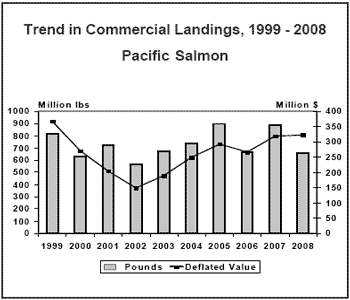
Sablefish
US commercial landings of sablefish were 43.3 million pounds valued at $124.6 million – a decrease of 592,000 pounds (1 per cent), but an increase of $9 million (8 per cent) compared with 2007. Landings decreased in Alaska to 30.3 million pounds – a decrease of 6 per cent compared with 2007. Landings decreased in Washington to 3 million pounds (down 3 per cent) but value increased to $7.3 million (up 11 per cent). The 2008 Oregon catch was 6.5 million pounds (up 22 per cent), and $13.7 million (up 45 per cent) compared with 2007. California landings of 3.5 million pounds and $6.2 million represent an increase of 8 per cent in quantity and almost 28 per cent in value from 2007. The average ex-vessel price per pound in 2008 was $2.88 compared with $2.63 in 2007.
Tuna
Landings of tuna by US fishermen at ports in United States, American Samoa, other US territories, and foreign ports were 298.8 million pounds valued at more than $202.4 million – an increase of 90.2 million pounds (43 per cent) and $47.3 million (30 per cent) compared with 2007. The average ex-vessel price per pound of all species of tuna in 2008 was 68 cents compared with 74 cents in 2007.
Big-eye landings in 2008 were 23.2 million pounds-a decrease of 1.2 million pounds (5 per cent) compared with 2007. The average ex-vessel price per pound was $2.43 in 2008, compared to $1.98 in 2007.
Skipjack landings were 211.2 million pounds-an increase of 81.3 million pounds (63 per cent) compared with 2007. The average ex-vessel price per pound was 38 cents in 2008, compared to 39 cents in 2007.
Yellowfin landings were 37.6 million pounds-an increase of 11.7 million pounds (45 per cent) compared with 2007. The average ex-vessel price per pound was 83 cents in 2008, compared with $1.14 in 2007.
Bluefin landings were 726,000 pounds-an increase of 85,000 pounds (13 per cent) compared with 2007. The average ex-vessel price per pound in 2008 was $6.55 compared with $5.59 in 2007.
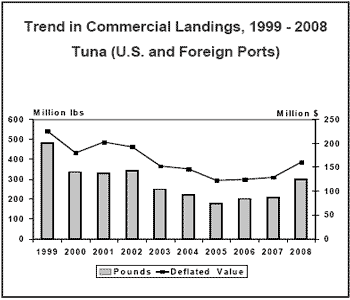
Clams
Landings of all species yielded nearly 107.8 million pounds of meats valued at almost $186.7 million – a decrease of nearly 8.1 million pounds (7 per cent) and $7.4 million (4 per cent) compared with 2007. The average ex-vessel price per pound in 2008 was $1.73 compared with $1.68 in 2007.
Surf clams yielded 57.3 million pounds of meats valued at $36.7 million – a decrease of nearly 5.5 million pounds (9 per cent) and $1.9 million (5 per cent) compared with 2007. New Jersey was the leading state with over 39.3 million pounds (down 12 per cent compared with 2007), followed by New York, 8.8 million pounds (down 4 per cent); and Massachusetts, 2.3 million pounds (up 28 per cent). The average ex-vessel price per pound of meats was 64 cents in 2008, up 3 cents from 2007.
The ocean quahog fishery produced 34.4 million pounds of meats valued at $20.4 million – a decrease of 326,000 pounds (1 per cent) and $222,000 (1 per cent) compared with 2007. Massachusetts had landings of 18.1 million pounds (down 10 per cent compared with 2007) valued at nearly $9.6 million (down 5 per cent) while New Jersey production was 12.2 million pounds (up 12 per cent) valued at $6.5 million (up 12 per cent). Together, Massachusetts and New Jersey accounted for more than 88 per cent of total ocean quahog production in 2008. The average ex-vessel price per pound of meats was 59 cents in 2008, unchanged from 2007.
The hard clam fishery produced over 7.3 million pounds of meats valued at $49.8 million – a decrease of over 2.3 million pounds (24 per cent) and $6.8 million (12 per cent) compared with 2007. Landings in the New England region were nearly 1.5 million pounds of meats (down 69 per cent); Middle Atlantic, 3 million pounds (up 61 per cent); Chesapeake, nearly 2.1 million pounds (down 6 per cent); and the South Atlantic region, 613,000 pounds (down 7 per cent). The average ex-vessel price per pound of meats increased from $5.86 in 2007 to $6.79 in 2008.
Soft clams yielded 3.8 million pounds of meats valued at almost $21.6 million – a decrease of 131,000 pounds (3 per cent) and $2.7 million (11 per cent) compared with 2007. Maine was the leading state with 1.9 million pounds of meats (down 4 per cent), followed by Massachusetts, 1.1 million pounds (down 15 per cent), and Rhode Island, 146,000 pounds (down 46 per cent). The average ex-vessel price per pound of meats was $5.67 in 2008, compared with $6.17 in 2007.
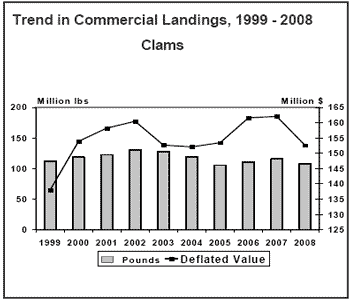
Crabs
Landings of all species of crabs were 325.2 million pounds valued at $562.3 million – an increase of 31.2 million pounds (11 per cent) and $90.5 million (19 per cent) compared with 2007.
Hard blue crab landings were 155.3 million pounds valued at $160.9 million – an increase of 9.3 million pounds (6 per cent) and $22.5 million (16 per cent) compared with 2007. Louisiana landed 26 per cent of the total US landings followed by: Maryland, 24 per cent; North Carolina, 21 per cent; and Virginia, 11 per cent. Hard blue crab landings in the Chesapeake region were 54 million pounds – an increase of 17 per cent; the South Atlantic with 44.8 million pounds increased 35 per cent; and the Gulf region with 47 million pounds decreased 18 per cent. The Middle Atlantic region with 9.5 million pounds valued at nearly $11.8 million had an increase of 368,000 pounds (4 per cent) compared with 2007. The average ex-vessel price per pound of hard blue crabs was $1.04 in 2008, compared with 95 cents in 2007.
Dungeness crab landings were 49.9 million pounds valued at $118.7 million – a decrease of 7.1 million pounds (12 per cent) and $14.4 million (11 per cent) compared with 2007. Washington landings of 21.4 million pounds (down 5 per cent from 2007) led all states with 43 per cent of the total landings. Oregon landings were 13.9 million pounds (down 18 per cent) or 28 per cent of the total landings. California landings were 8.5 million pounds (down 23 per cent) and Alaska landings were 6.2 million pounds (down 5 per cent). The average ex-vessel price per pound was $2.38 in 2008, compared with $2.33 in 2007.
US landings of king crab were 27.2 million pounds valued at $120.2 million – an increase of almost 1.3 million pounds (5 per cent) and $22.3 million (23 per cent) compared with 2007. The average ex-vessel price per pound in 2008 was $4.42 compared with $3.77 in 2007. Snow crab landings were 62.4 million pounds valued at $101.2 million – an increase of 28.3 million pounds (83 per cent) and $50.8 million (100 per cent) compared with 2007. The average ex-vessel price per pound was $1.62 in 2008, up from $1.48 in 2007.
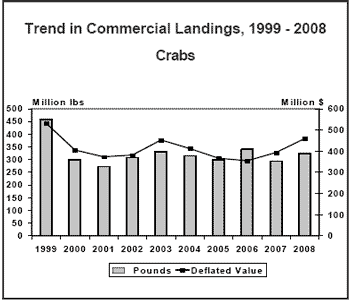
Lobster, American
American lobster landings were 81.8 million pounds valued at $306.2 million – an increase of 532,000 pounds (1 per cent), but a decrease of $69.4 million (18 per cent) compared with 2007. Maine led in landings for the 27th consecutive year with 63.4 million pounds valued at $222.6 million-a decrease of 961,000 pounds (1 per cent) compared with 2007. Massachusetts, the second leading producer, had landings of 10.5 million pounds valued at $45.1 million-an increase of 354,000 pounds (3 per cent) compared with 2007. Together, Maine and Massachusetts produced over 90 per cent of the total national landings. The average ex-vessel price per pound was $3.74 in 2008, compared with $4.62 in 2007.
Lobster, Spiny
US landings of spiny lobster were 4.2 million pounds valued at $30.7 million–a decrease of 231,000 pounds (5 per cent) and $3.2 million (9 per cent) compared with 2007. Florida, with landings of almost 3.5 million pounds valued at nearly $22.8 million, accounted for more than 82 per cent of the total catch and 74 per cent of the value. This was a decrease of 304,000 pounds (8 per cent) and $4.2 million (16 per cent) compared with 2007. Overall the average ex-vessel price per pound was $7.32 in 2008, compared with $7.67 in 2007.
Oysters
US oyster landings yielded 30.2 million pounds valued at $131.6 million – a decrease of 7.6 million pounds (20 per cent) and $7.7 million (5 per cent) compared with 2007. The Gulf region led in production with 20.3 million pounds of meats, 67 per cent of the national total; followed by the Pacific Coast region with 7.5 million pounds (25 per cent), principally Washington, with 6.1 million pounds (almost 82 per cent of the region’s total volume); and the South Atlantic region with 774,000 pounds (3 per cent). The average ex-vessel price per pound of meats was $4.36 in 2008, compared with $3.69 in 2007.
Scallops
US landings of bay and sea scallops totaled almost 53.7 million pounds valued at almost $371.6 million – a decrease of 5.1 million pounds (almost 9 per cent) and $15.8 million (4 per cent) compared with 2007. The average ex-vessel price per pound of meats increased from $6.60 in 2007 to $6.93 in 2008.
Bay scallop landings were 131,000 pounds valued at $1.8 million – a decrease of 53,000 pounds (29 per cent), but an increase of $215,000 (14 per cent) compared with 2007. The average ex-vessel price per pound of meats was $13.60 in 2008, compared with $8.51 in 2007.
Sea scallop landings were almost 53.5 million pounds valued at $369.9 million – a decrease of 5 million pounds (9 per cent) and $16.1 million (4 per cent) compared with 2007. Massachusetts and New Jersey were the leading states in landings of sea scallops with 27.1 million and over 13.3 million pounds of meats, respectively, representing 75 per cent of the national total. The average ex-vessel price per pound of meats in 2008 was $6.91 compared with $6.59 in 2007.
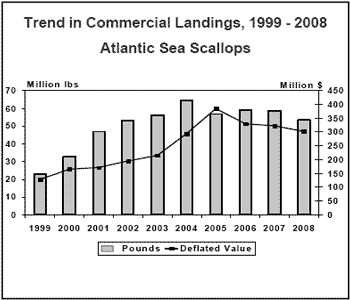
Shrimp
US landings of shrimp were 256.6 million pounds valued at $441.8 million – a decrease of 24.3 million pounds (9 per cent), but an increase of $9.1 million (2 per cent) compared with 2007. Shrimp landings by region were: New England up 9 per cent; South Atlantic up 9 per cent; Gulf down 16 per cent; and Pacific up 38 per cent.
The average ex-vessel price per pound of shrimp increased to $1.72 in 2008 from $1.54 in 2007.
Gulf region landings were the nation’s largest with 188.3 million pounds and 73 per cent of the national total. Louisiana led all Gulf states with 89 million pounds (down 20 per cent compared with 2007); followed by Texas, 63.8 million pounds (down 14 per cent); Alabama, 17 million pounds (down 20 per cent); Florida West Coast, 9.9 million pounds (up 15 per cent); and Mississippi, almost 8.6 million pounds (down 18 per cent). In the Pacific region, Oregon had landings of 25.4 million pounds (up 27 per cent compared with 2007); Washington had landings of 7.2 million pounds (up 69 per cent); and California, 3 million pounds (up 140 per cent).
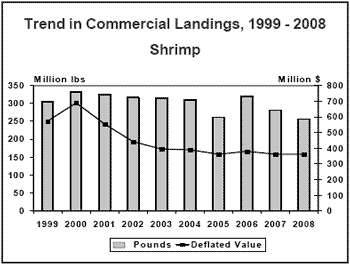
Squid
US commercial landings of squid were 145.8 million pounds valued at $57.6 million – a decrease of 13.3 million pounds (8 per cent), but an increase of $1.1 million (2 per cent) compared with 2007. California was the leading state with almost 80.7 million pounds (55 per cent) and was followed by New Jersey with 23 million pounds (16 per cent of the national total). The Pacific Coast region landings were 85.5 million pounds (down 24 per cent compared with 2007); followed by Middle Atlantic, over 31.3 million pounds (up 54 per cent); followed by the New England region with almost 28.6 million pounds (up 8 per cent); followed by the Chesapeake region with 227,000 pounds (up 83 per cent); and the South Atlantic region with 127,000 pounds (down 59 per cent). The average ex-vessel price per pound for squid was 39 cents in 2008, compared with 35 cents in 2007.
Further Reading
| - | You can view the full report by clicking here. |
September 2009

